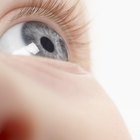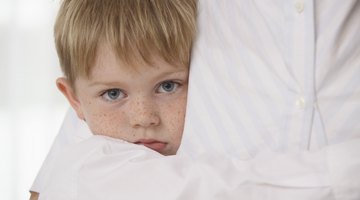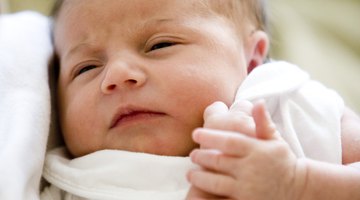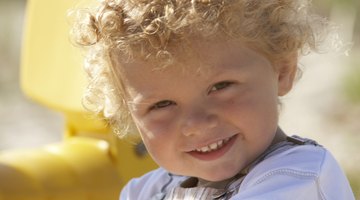How to Determine a Baby's Hair Color
When you’re expecting a baby, it’s natural to wonder how she will look.
As you envision her future, keep in mind that genetics can influence many of her physical traits, like her hair color. While scientists don’t know a lot about hair color inheritance, they do know that the production of melanin plays a significant role, according to the Tech Museum of Innovation.
Genetic Considerations
The proteins within a baby’s genetic code contribute to the production of melanin in his hair, according to a 2008 study on the Public Library of Science website. Genes also affect how melanosomes, organelles that pigment tissues, mature. Between four and six genes determine an individual’s hair color, according to professor C. George Boeree of Shippensburg University. The alleles within the genes are dominant or recessive.
Some alleles may have incomplete, or partial, dominance, a mix of dominant and recessive traits. While genes traits may help predict a baby’s hair color, they don’t explain why a person’s hair color may change as he ages.
Eumelanin vs. Pheomelanin

Can a Baby's Eyes Get Lighter With Time?
Learn More
Two types of melanin affect hair color: pheomelanin and eumelanin. Pheomelanin is what make hair have shades of yellow and orange. Eumelanin colors it black and brown. A blend of the two types of melanin is what gives an individual her hair color, according to Christoph G. Birngruber and Marcel A. Verhoff in the book “Handbook of Hair in Health and Disease.” When a baby has lower concentrations of eumelanin, she will have light-colored hair.
High concentrations of eumelanin result in brown or black hair. The tryosinase enzyme affects the production of either type of melanin. Birngruber and Verhoff state that the melanocortin-1-receptor, or MC1R, gene regulates the type of melanin the body produces.
When a mutation in the genes causes the body to produce only pheomelanin, a baby will have red hair. People with red and blond hair have higher levels of tryosinase than those with brown or black hair.
Dominant and Recessive Traits
The observable traits of genes, like how a person looks, are phenotypes. Dominant and recessive alleles contribute to an individual’s phenotype. Each person has two alleles. A baby inherits a random allele from each parent. When a baby has a dominant phenotype, he inherited a dominant allele from one or both parents. To inherit a recessive phenotype, he must inherit recessive alleles from both parents. The alleles that result in black and brown hair are dominant, while those that produce blond and red hair are recessive, according to Boeree. If two parents with dark hair have a dominant and recessive allele, but their baby inherits both recessive alleles, the child may have blond hair.
Similarly, if each parent has the recessive allele for red hair and a baby inherits the recessive alleles, he may have red hair. Variations in the expression of eumelanin and pheomelanin in a person’s genetic sequence can produce different hair colors, such as dirty blond, strawberry blond, auburn, light brown or dark brown hair.
Looking to the Future

Do Babies Get Their Eye Color From Mom or Dad?
Learn More
A baby’s hair and eyebrow color at birth doesn’t necessarily indicate what her hair color will be as a child or as an adult.
As a baby gets older, a transcription factor protein can turn a gene on or off, according to the Tech Museum of Innovation. So, a baby’s hair could become darker as she grows up. When the tyrosinase activity in the melanin reduces as a person ages, her hair will turn gray or white.
Related Articles
- The Tech Museum of Innovation: Hair Color
- PLOS.org: A Genome-Wide Association Study Identifies Novel Alleles Associated with Hair Color and Skin Pigmentation
- Shippensburg University: Race
- Handbook of Hair in Health and Disease: Christoph G. Birngruber and Marcel A. Verhoff
- The Tech Museum of Innovation: Dominant vs. Recessive
- The Tech Museum of Innovation: Hair Color











